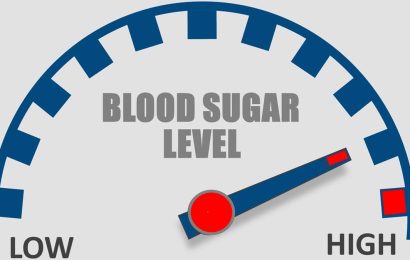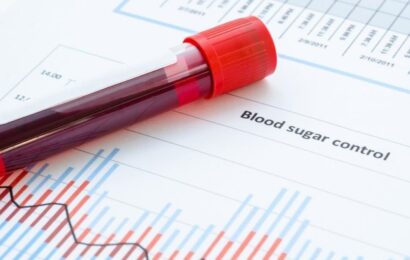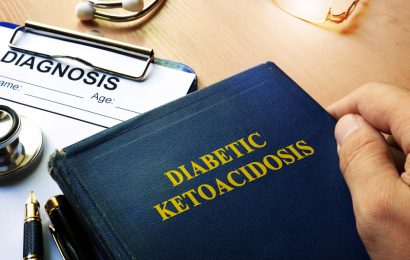Today’s the big day! After months of working hard to achieve tight blood glucose control and actually succeeding most of the time, you’re about to get the result of your latest glycosylated hemoglobin (HbA1c) test, the blood test that gives you an indication of your overall blood glucose control over the previous 2–3 months.
“It’s just got to be lower than last time,” you think as you wait in your doctor’s exam room. “I’ve been good. Really good. My average on my meter is lower than it’s been in years. He’s going to be impressed for sure. No lectures about the risks associated with a high A1c this time! I’ll be out of here in 10 minutes, easy.”
In walks your doctor, with the results of your latest lab work in hand. Thirty minutes later, after a series of careful examinations and a lengthy lecture on the need to get your HbA1c down, you walk out shaking your head.
— Learn More About Blood Glucose Management >>
“I don’t get it. How can my A1c still be so high? My mealtime readings are almost always where they should be. It just doesn’t make sense. Maybe the lab made a mistake. Maybe my blood is different from everyone else’s.”
Or maybe you’ve been the victim of postprandial hyperglycemia.
Post-what?
Postprandial hyperglycemia refers to high blood glucose levels that occur soon after eating meals or snacks. For anyone with diabetes, it is normal for blood glucose to rise somewhat after eating. But if your after-meal rises are dramatic and occur consistently, they can result in higher HbA1c test results than your premeal blood glucose readings would otherwise indicate, and the higher your HbA1c, the higher your risk of serious diabetes complications.
The HbA1c reflects an average of all blood glucose levels at all times of day — before eating, after eating, during the night, etc. — over 2–3 months. (To see how HbA1c levels compare to average blood glucose levels, see the table “Blood Glucose and HbA1c Correlations.”) However, research presented in 2004 suggests that a person’s HbA1c correlates closely to his average blood glucose levels during the three hours after — not before — eating. So even though after-meal high blood glucose levels are temporary (often resembling a spike when plotted on a graph), frequent between-meal rises can cause your HbA1c to go up.
Research on the effects of postprandial hyperglycemia has shown an increase in the risk of death from heart disease in those with Type 2 diabetes and earlier onset of kidney disease in those with Type 1. But postprandial hyperglycemia can have more immediate effects as well. Just as a big turkey dinner can turn the peppiest person into a slumbering slug, a rapid rise in blood glucose levels after meals has been shown to affect the ability to concentrate, stay alert, and perform athletically and intellectually.
How high is too high?
In most cases, blood glucose levels peak about an hour after finishing a meal or snack. Ideally, the blood glucose level at the peak should be below 180 mg/dl, or less than 80 mg/dl higher than it was before the meal. With children, after-meal peaks can be a bit more liberal. Teenagers should try to keep peaks below 200 mg/dl, school-age children below 225 mg/dl, and pre-schoolers and toddlers below 250 mg/dl.
In practice, these ideals may not be achieved by many. Research conducted at Yale University on children with Type 1 diabetes indicated that after-meal blood glucose peaks are generally much higher than the recommended levels. After breakfast, the average peak blood glucose level was 293 mg/dl; after lunch it was 291 mg/dl; after dinner, 280 mg/dl. In fact, nearly half (46%) of meals were followed by a blood glucose peak of over 300 mg/dl!
Detecting the spikes
A number of good options exist for measuring after-meal blood glucose spikes. Perhaps the most practical is to check your blood glucose level about one hour after completing a meal or snack using a blood glucose meter. When checking your blood glucose level after meals or snacks, you should use a blood sample from a finger rather than an alternate site sample. Because of the way blood circulates in the body, samples from the fingers may show changes in blood glucose level sooner than samples from other sites. Check before and after breakfast, lunch, and dinner several times to determine whether postprandial spikes are a problem at a specific meal. It is more common to see significant spikes after breakfast than at other meals, but it is worth checking after each meal just to make sure.
When interpreting your results, take your premeal readings into account since you are interested in not just your after-meal reading but also in how much your blood glucose level increased because of your food intake. For example, a postmeal blood glucose reading of 240 mg/dl following a premeal reading of 210 mg/dl shows just a 30-point rise, whereas a 240 mg/dl following a 110 mg/dl shows a 130-point rise. Having a mildly low blood glucose value (around 65 mg/dl, for example) before a meal can result in a temporary “rebound” to a higher-than-usual level after the meal and may not reflect a true postprandial spike.
Another option for analyzing after-meal blood glucose levels is the GlucoWatch Biographer from Cygnus Corporation. The GlucoWatch takes readings every 10 minutes by measuring the concentration of glucose in the interstitial fluid just below the skin. The data can be reviewed manually or transferred to a computer for analysis. However, one of the problems with using the GlucoWatch is its tendency to “skip” readings during periods of rapid blood glucose rise or fall, as usually occurs soon after eating.
A more detailed analysis of after-meal blood glucose can be obtained through use of the Continuous Glucose Monitoring System (CGMS) from Medtronic MiniMed. The CGMS can be worn for up to three days and measures glucose levels in interstitial fluid by way of a tiny sensor inserted just below the skin. It does not provide immediate data. Instead, the information is transferred to a computer after the sensor is disconnected from the skin. The software provides statistics and graphic printouts that allow you and your health-care team to see exactly how much your blood glucose levels are rising after meals and snacks. (See sample printouts in “How Bolus Timing Affects After-Meal Spikes”).
Spike control
Reducing after-meal spikes does not always mean taking more insulin or oral medicine at mealtimes. In fact, if your premeal readings are already close to normal, increasing your dose of insulin or oral medicine would result in low blood glucose before the next meal. Remember, the idea is to reduce the between-meal peak, but not necessarily lower the blood glucose level before the next meal.
To accomplish this feat, a number of strategies can be used, including the following:
Get moving. Physical activity after eating has a multitude of benefits. If insulin was taken with the meal or snack, the enhanced blood flow to the skin surface caused by physical activity is likely to make the insulin get absorbed quicker so that it can act quicker. This means that the insulin will do a better job of keeping the blood glucose from rising too high right after eating. In addition, muscle activity diverts blood flow away from the intestines, resulting in slower absorption of glucose and other simple sugars into the bloodstream. The sugars that do enter the bloodstream are likely to be “consumed” by the working muscles.
How much activity is required to experience these benefits? Not much. Ten or 15 minutes (or more) of mild activity will get the job done. The key is to avoid sitting for extended periods after eating. Instead of reading, watching TV, or working on the computer, go for a walk, shoot some hoops, or throw a few darts. In the course of your usual day, try to schedule your active tasks (housework, yardwork, chores, errands, walking pets) for after meals. Make an attempt to schedule your exercise sessions for after meals to take advantage of their blood-glucose-lowering effect. (Individuals with heart disease or other circulatory complications should consult their physician before attempting to exercise after eating.) When you go out for a meal, resist the urge to sit and talk for hours or head straight for a movie. Instead, get up and go out dancing, bowling, or skating.
Think lower GI. The glycemic index of a food refers to the speed with which the food raises blood glucose level. While all carbohydrates (except for fiber) convert into glucose eventually, some do so much faster than others.
Many starchy foods, including many types of bread, cereals, potatoes, and rice have a high glycemic index; they digest easily and convert into glucose quickly. Some starchy foods, including pasta, beans, and peas, have a lower glycemic index because the starches contained in them do not digest as easily. Similarly, some sweet foods have a high glycemic index while others do not. Table sugar (sucrose), for example, has a moderate glycemic index. Foods that contain fiber or fat tend to have lower glycemic index values than foods that do not. Foods in solid form tend to have a lower GI than similar foods in liquid or “sauce” form, and cold foods tend to digest more slowly than hot foods.
A number of books contain extensive information about the glycemic index, including Dr. Jennie Brand-Miller’s Glucose Revolution series, which is readily available in bookstores. For a list of the glycemic index values of many common foods, see “Glycemic Index of Common Foods.” (Higher numbers mean faster conversion to glucose.) Substituting foods with a lower glycemic index for foods with a higher glycemic index in your diet will help to reduce your after-meal blood glucose spikes.
Medicate wisely. Whether you take insulin or oral medicines to control your blood glucose levels, the right program can make or break your ability to control those after-meal spikes. In general, insulin and medicines that work slowly over a prolonged period do a poorer job of controlling after-meal spikes than those that work quickly and for a short period.
For insulin to control after-meal spikes, the insulin’s “peak” action must match the peak blood glucose level after eating. If you take a morning injection of NPH to “cover” the food you eat in the middle of the day, your postprandial blood glucose is likely to be very high after lunch and after any late-morning or afternoon snacks. That’s because the peak for these insulins is less pronounced than that of the rapid-acting insulins and it is spread over several hours. To remedy this, consider taking a dose of a rapid-acting insulin analog such as lispro (brand name Humalog) or aspart (NovoLog) before each meal and snack, with an intermediate insulin at nighttime only.
Even Regular insulin, with a peak taking place 2–3 hours after injection, rarely works as well at controlling after-meal blood glucose levels as does lispro or aspart, both of which peak about an hour after injection.
Your choice of oral medicine can also affect your after-meal control. Sulfonylureas (glyburide, glipizide, glimepiride), which are generally taken once or twice a day, stimulate the pancreas to secrete a little extra insulin throughout the day, without regard to meal timing. Because these medicines fail to concentrate the insulin secretion at times when it is needed most, after-meal blood glucose levels can run very high. However, the drugs repaglinide and nateglinide, which also stimulate the pancreas to secrete more insulin, are much faster- and shorter-acting. When taken at mealtimes, these drugs stimulate the pancreas to secrete extra insulin for a concentrated period of time, thus producing better after-meal control.
Another class of diabetes medicines called alpha-glucosidase inhibitors improve after-meal control by partially blocking the transport of some carbohydrates across the intestines and into the bloodstream. However, these drugs can sometimes cause temporary gas, bloating, and gastrointestinal upset. You might recall that physical activity after meals will also slow the movement of carbohydrates into the bloodstream, but without the side effects!
Back up your bolus. In the real world, the fourth dimension (time) is of the essence. The timing of your mealtime insulin doses (often called boluses) can significantly affect how high your blood glucose level rises after meals. Boluses given too late to match the digestion of most carbohydrates can result in significantly high blood glucose soon after eating. However, a properly timed bolus can result in excellent after-meal control.
The advice presented here assumes that you are using either lispro or aspart for your mealtime boluses. If you use Regular insulin, either by itself or premixed with NPH, take all the advice given below and back everything up by 20–30 minutes. It is also assumed that you do not have a condition that impairs your digestion, such as gastroparesis (a nerve disorder that slows emptying of the stomach) or gastritis (nausea and upset stomach). These conditions can significantly delay the rate at which carbohydrates raise blood glucose level, and they usually require that boluses be administered after food has been consumed.
Foods with a high glycemic index (greater than 70), such as cold cereals, bread, potatoes, rice, and snack chips, tend to raise blood glucose the fastest, with a significant peak occurring in 30–60 minutes. For these types of foods, it is best to bolus 15–20 minutes prior to eating. This will allow the insulin peak to coincide as closely as possible with the blood glucose peak. And that, of course, will produce the best possible after-meal control. Bolusing for high-GI foods as you are eating them will cause an after-meal spike, because the insulin action will lag behind the blood glucose rise by almost half an hour.
Foods with a moderate glycemic index (approximately 45–70) digest a bit slower, resulting in a slightly less pronounced blood glucose peak approximately 60–90 minutes after eating. Examples include ice cream, orange juice, cake, and carrots. It is best to bolus immediately prior to eating foods with a moderate GI. This will allow the insulin peak to closely match carbohydrate digestion and result in the best possible after-meal control.
Foods with a low glycemic index (below 45) tend to cause a slow, gradual blood glucose rise. The blood glucose peak is usually modest and may take several hours to appear. Examples of foods with a low glycemic index include pasta, milk, yogurt, and kidney beans. For these types of foods, a few bolus options are available. One option is to bolus 10–15 minutes after finishing your main course. This usually gives the food enough of a head start before the insulin kicks in. A second option is to split the bolus into two or three parts and to take each about an hour apart, starting at the mealtime. A third option is to take Regular insulin with the meal, rather than a rapid-acting insulin analog. One other option, available to users of insulin pumps, is to extend the bolus delivery over an hour or two.
Another variable to consider when determining the timing of your mealtime bolus is your premeal blood glucose level. To avoid an after-meal drop or spike in your blood glucose level, it is best to give the bolus earlier when your blood glucose is elevated and later when it is below your target. The chart “Bolus Timing in Relation to Meals” combines the glycemic index and premeal blood glucose level to determine optimal bolus timing.
Does earlier bolusing make a difference? Check out the results of my own CGMS reports. The first was taken six months ago, when I was bolusing just as I would sit down to eat. Notice the after-meal spikes. The second was taken more recently, with boluses taken 15 minutes before each of my meals and snacks. Notice the lack of after-meal peaks!
Mull, measure, and manage
Postprandial blood glucose spikes are a force to be reckoned with. The acute and chronic problems caused by after-meal highs can be significant. Start by looking at your after-meal blood glucose levels from time to time, and determine whether a problem exists. If it does, take the necessary steps to achieve better after-meal control. Get some activity after eating. Make wiser food choices. And make sure your oral medicine or insulin program is working in your favor.
With better after-meal control, perhaps your next HbA1c will be right where you want, expect, and deserve it to be!





